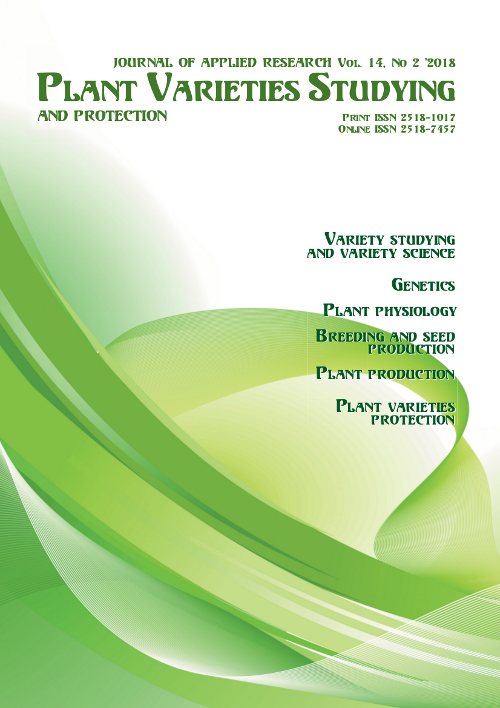Changes in chlorophyll content of lavender (<i>Lavandula angustifolia</i> L.) over organogenetic stages
DOI:
https://doi.org/10.21498/2518-1017.14.2.2018.134763Keywords:
lavender, chlorophylls a and b, vegetation, adaptation, Ukrainian Forest-SteppeAbstract
Purpose. To determine the peculiarities of the chlorophylls a and b biosynthesis in the leaves of lavender over the stages of organogenesis under the conditions of the Right Bank Forest-Steppe of Ukraine.
Methods. The subject of the study was eight varieties of lavender of Ukrainian and foreign breeding: ‘Feuervogel’, ‘Livadia’, ‘Orion’, ‘Vostok’, ‘König Humberg’, ‘Maestro’, ‘Veseli Notky’ and ‘Richard Walls’ from the collection of ornamental and medical plants of the Institute of Horticulture of the National Academy of Sciences of Ukraine. Samples of vegetative material were taken at experimental stock sites during a period 2015 to 2017 at the following stages of organogenesis: the beginning of vegetation, the complete formation of leaves, the formation of buds, the beginning of flowering and full flowering. The content of chlorophyll in the leaves was determined by the Godnev’s method modified by Osipova (1947).
Results. A positive dynamics of chlorophyll types a and b accumulation in the leaves of lavender plants over the stages of organogenesis under the conditions of the Kyiv region was found. At the flowering stage, the total content of these pigments in the leaves of varieties under investigation reached a maximum and ranged from 1.8 to 2.0 g/dm2, which was 18.8 to 25.0% higher than the values of the previous stage of development. Variety-specific relations in biosynthesis in chlorophyll a and b was revealed. The highest chlorophyll a content at the flowering stage was recorded in ‘Vostok’ and ‘Maestro’ varieties (1.64 g/dm2), while chlorophyll b in ‘Orion’ (0.64 g/dm2) and ‘König Humberg’ (0.52 g/dm2).
Conclusions. The peculiarities of the changes in the chlorophyll content of lavender plants over the stages of organogenesis are determined, that allows evaluating the effect of growing conditions on the state of plantations of various lavender varieties and can be used to optimize the technology of lavender cultivation.
Downloads
References
Andrianova, Yu. Ye., & Tarchevskiy, I. А. (2000). Khlorofill i produktivnost’ rasteniy [Chlorophyll and plant productivity]. Moscow: Nauka. [in Russian]
Shlyk, А. А. (Ed.). (1974). Khlorofill [Chlorophyll]. Minsk: Nauka i tekhnika. [in Russian]
Tarchevskiy, I. A. (2002). Khlorofill i produktivnost’ sel’skokhozyaystvennykh rasteniy [Chlorophyll and crops productivity]. Moscow: Nauka. [in Russian]
Highkin, H. R., & Frenkel, A. W. (1962). Studies of growth & metabolism of a barley mutant lacking chlorophyll b. Plant Physiol., 37(6), 814–820.
Osipova, O. P. (1947). About the chlorophyll extraction from green plants. Dokl. Akad. Nauk SSSR [Proceedings of the Academy of Sciences of the USSR], 57(8), 799–801. [in Russian]
Tutin, T. G., Heywood, V. H., Burges, N. A., Moore, D. M., Valentine, D. H., Walters, S. M., Webb, D. A. (Eds.). Flora Europaea. Vol. 3: Diapensiaceae to Myoporaceae. Cambrige: Cambrige University Press, 1972. 370 p.
Rudnyk-Ivashhenko, O. I., & Kremenchuk, R. I. (2017). Lavender (Lavandula angustifolia) in the Forest-Steppe zone of Ukraine. In Naukove zabezpechennia innovatsiinoho rozvytku ahropromyslovoho kompleksu v umovakh zmin klimatu: materialy Mizhn. nauk.-prakt. konf. molodykh vchenykh i spetsialistiv [Scientific provision of innovative development of agro-industrial complex in the conditions of climate change: Proc. Int. Sci. and Pract. Conf. of Young Scientists and Specialists] (pp. 135–136). May 25–26, 2017, Dnipro, Ukraine. [in Ukrainian]
Lim, P. O., Kim, Y., Breeze, E., Koo, J. C., Woo, H. R., Ryu, J. S., … Nam, H. G. (2007). Overexpression of a chromatin architecture-controlling AT-hook protein extends leaf longevity and increases the post-harvest storage life of plants. Plant J., 52(6), 1140–1153. doi: 10.1111/j.1365-313X.2007.03317.x
Zapata, J. M., Guera, A.,Esteban-Carrasco, A., Martin, M., & Sabater, B. (2005). Chloroplastsregulateleafsenescence: delayedsenescenceintransgenic ndhF-defectivetobacco. Cell Death Differ., 12(10), 1277–1284. doi: 10.1038/sj.cdd.4401657
Parrott, D. L., Martin, J. M., & Fischer, A. M. (2010). Analysis of barley (Hordeum vulgare) leaf senescence and protease gene expression: a family C1A cysteine protease is specifically induced under conditions characterized by high carbohydrate, but low to moderate nitrogen levels. NewPhytol., 187(2), 313–331. doi: 10.1111/j.1469-8137.2010.03278.x
Thomas, H. (1997). Chlorophyll: a symptom and a regulator ofplastiddevelopment. New Phytol., 136(2), 163–181. doi: 10.1046/j.1469-8137.1997.00737.x
Downloads
Published
How to Cite
Issue
Section
License
Copyright (c) 2018 Ukrainian Institute for Plant Variety Examination

This work is licensed under a Creative Commons Attribution-ShareAlike 4.0 International License.
Starting in 2022, the copyright to the publication remains with the authors
Our journal abides by the CREATIVE COMMONS copyright rights and permissions for open access journals.
Authors, who are published in this journal, agree to the following conditions:
- The authors reserve the right to authorship of the work and pass the first publication right of this work to the journal under the terms of a Creative Commons Attribution License, which allows others to freely distribute the published research with the obligatory reference to the authors of the original work and the first publication of the work in this journal.
- The authors have the right to conclude separate supplement agreements that relate to non-exclusive work distribution in the form in which it has been published by the journal (for example, to upload the work to the online storage of the journal or publish it as part of a monograph), provided that the reference to the first publication of the work in this journal is included.

























 Ukrainian Institute for Plant Varieties Examination
Ukrainian Institute for Plant Varieties Examination  Селекційно-генетичний інститут
Селекційно-генетичний інститут Institute of Plant Physiology and Genetics of the National Academy of Sciences of Ukraine
Institute of Plant Physiology and Genetics of the National Academy of Sciences of Ukraine
 The National Academy of Agrarian Sciences of Ukraine
The National Academy of Agrarian Sciences of Ukraine